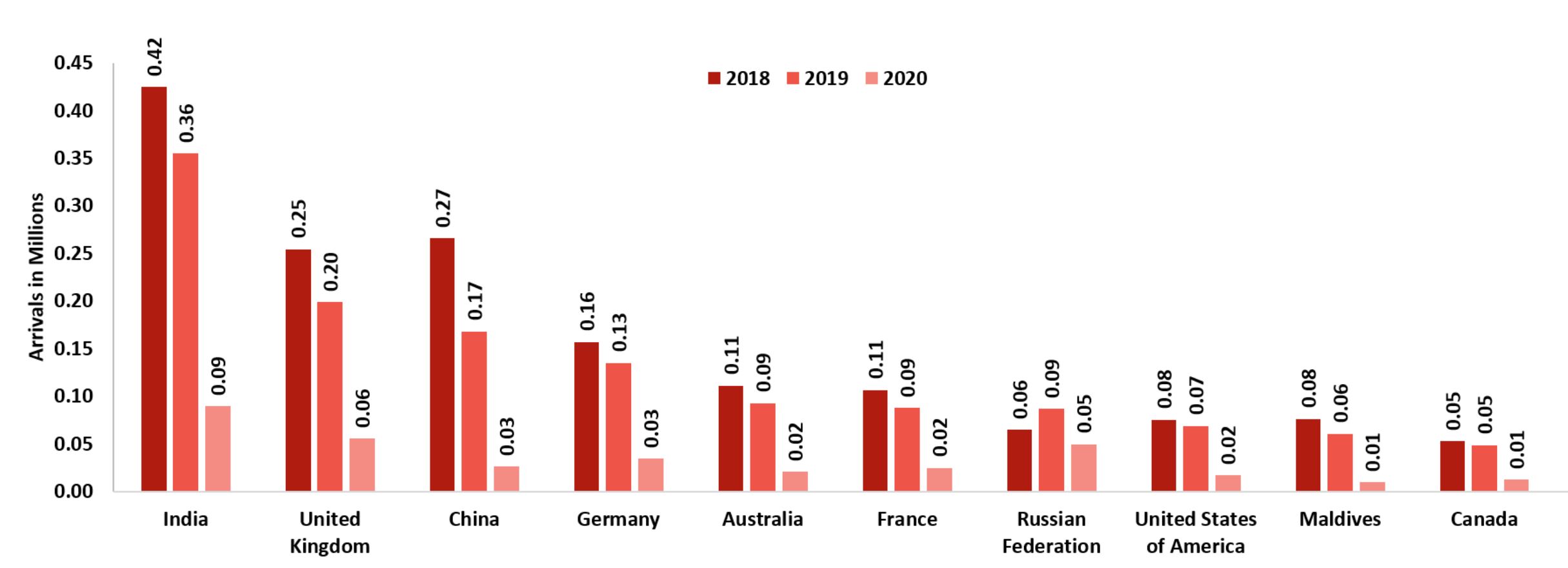HVS Monday Musings: Sri Lanka Tourism – The Post-war Growth Story
The island nation of Sri Lanka has emerged as one of the most sought-after tourist destinations in South Asia since the three-decade-long civil war in the country ended in 2009. The country, popularly known as the Pearl of the Indian Ocean due to its rich natural beauty and cultural heritage, offers tourists a plethora of experiences with multiple attractions ranging from pristine beaches, beautiful rainforests, tea plantations, wildlife parks, to historical sites, ancient ruins, temples and even casinos. The country’s tourism sector bounced back immediately after the war, becoming the key economic driver in post-war Sri Lanka.
The tourism industry witnessed unprecedented growth from 2008 to 2018, with tourist arrivals growing at a CAGR of 18% during the period and foreign exchange earnings increasing at a CAGR of 34.4%. The tourism sector has steadily improved its ranking from the fifth-largest foreign exchange earner in 2010 to the third-largest source by 2018. Improved infrastructure, the development of new hotels, an increasing number of tourist activities, and government initiatives helped Sri Lanka to be named as the top travel destination by Lonely Planet in 2019.
Government initiatives have helped boost tourism in the country.
The Sri Lankan government, fully cognizant that good infrastructure is necessary for the country to achieve economic and tourism growth, has constantly focused on bringing foreign aid into the country to build infrastructure projects. The last decade has seen massive infrastructure development in the form of roads, railways, bridges, ports, and a second international airport, all of which have aided tourism growth.
The government also streamlined the tourism sector's regulatory framework by setting up a 'One-Stop Unit (OSU)' to assist potential investors. Several incentives, such as VAT exemption, tax holidays for hotel development, tax exemption for MICE organizations, subsidies for the development of medical tourism facilities, and zero import duties on caravans, yachts, surfing equipment, and mini cruise boats, among others, have helped increase investment in the sector over the years. The government also launched effective marketing campaigns to negate the bad publicity the country got during the civil war and to rebuild its image as a safe tourist destination. Electronic visa authorization was also introduced to ease travel into the country.
Tourist Arrivals in Sri Lanka 2008 - 2020
However, the sector is currently witnessing a temporary slowdown.
The relentless pace of growth of the Sri Lankan tourism sector was deeply impacted by the terror attacks in the country in 2019. Over 250 lives were lost, including at least 45 foreign nationals, in the Easter bombings targeting Christians at three churches and tourists residing in three luxury hotels in the commercial capital of Colombo. The tourism sector witnessed a massive slump in the wake of the bombings, with an 18% drop in tourist arrivals. However, Sri Lanka offered a raft of discounts, scrapped fees on tourist visas for 48 nations, and adopted an effective marketing campaign to attract tourists post-crisis, helping a gradual revival of the tourism industry.
Just when the sector was starting to recover, the COVID-19 pandemic wreaked havoc, severely crippling the travel and tourism sector in 2020. Sri Lanka's tourism industry has been significantly affected due to the travel disruptions and restrictions issued across the globe to contain the pandemic. Tourist arrivals to Sri Lanka declined by approximately 74% in 2020, as all passenger flights and ship arrivals were suspended in March 2020. The effect of the outbreak was visible, with the top source countries recording a notable drop in tourist arrivals.
Top 10 Source Markets
Reviving tourism with strict protocols.
The country reopened its borders for tourism in January 2021, after a 10-month closure, under a bio-bubble concept. The tourists were not permitted to leave their hotels during the initial 14-day period. However, they were allowed to take approved tours to select tourist sites at particular times. As a result, in the first five months of 2021, close to 15,300 tourists have visited the country.
To revive the sector, the government has also announced numerous COVID relief measures such as VAT exemption, moratorium extension, waiving off renewal fees and liquor license fees for SLTDA licensed establishments, a grace period for utility payments and vehicle lease rentals, loan schemes for affected industries, and wage support schemes for hotels and travel agents, etc.
The rapid growth of the tourism industry in Sri Lanka before the anomalies of the last two years reflects the untapped potential of tourism in the country, with the sector poised to generate growth and investment opportunities. A combination of the right policies, infrastructure development, and effective marketing campaigns can help the country leverage the economic prospects of the tourism industry post the pandemic.
Additional Contributor to this article: Kavya Jain, Intern at HVS ANAROCK
Mandeep S Lamba
President (South Asia), New Delhi
+91 (124) 488 5552
HVS



